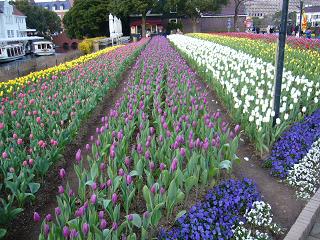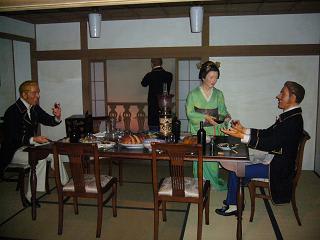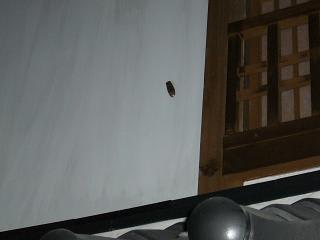The tulip festival in HUIS TEN BOSCH!


ハウステンボスでの私の一番のお気に入り シーボルトの館(?)です。壁にセミがとまってますよ。
I love the Siebold Museum. Do you make out a cicada on the white wall?


NHKの ”その時歴史が動いた”http://www.nhk.or.jp/sonotoki/ 時々観ます。
面白いですね。見応えありますね。
昨年 大村市の歴史案内人養成セミナーで 市役所の講師の方が 松平定知ばりに楽しく語ってくださった 幕末における大村藩の活躍。江戸幕府側につくか?倒幕か? この貧しい小さな大村藩も悩んだそうです。
当時 大村藩の財政は厳しく 今なおポピュラーな経費節減とか行政改革とかやってたらしく しかし例のごとくうまくはいかないもので・・・
そうこうしてる内に ”ペリーの黒舟”がやってきて ”ヤバイ!! アメリカの植民地にされるかも!” と日本中が騒ぎだし・・・。
実は以前から長崎にはオランダから船がくるので 長崎周辺にいた人々は おおかたの世界の動向を知っていました。
ペリーの約50年前 1808年に長崎港にやってきたイギリス船による フェートン号事件。鎖国下 日本が長崎でオランダとの貿易を行っていたとき フェートン号が出島のオランダ領を攻撃しにやって来たのです。イギリス人たちは出島に立てこもり 日本に食料の供給を要求しました。 日本は鎖国をしているので イギリス人との間で物の流通はありえません。なんだかんだで結局 当時の長崎奉行が責任をとって切腹をしたそうです。
もう鎖国は長くは続かないと長崎の人は思ったはずです。開国には弱腰だった江戸幕府。大村藩は左幕派と勤王派に分裂します。
大村藩勤王三十七士は幕末に倒幕を目指し結集した藩士達でした。中心人物の一人 松林飯山は非常に頭の良かった人で大村藩に勤王思想を広めましたが 1867年 左幕派によって暗殺され それは大村騒動とよばれる大捕り物へと発展します。結果として左幕は一掃され 大村藩は一丸となって倒幕へと動きはじめます。
幕府軍と新政府軍による戊辰戦争では京都、江戸、福島、秋田などで新政府軍として戦争に参加しました。
当時 薩摩藩と長州藩は仲が悪く 大村藩は両藩と仲良しでした。間にたって薩長同盟を結ばせ 倒幕を行うべく画策しました。 三十七士の一人 渡辺清は西郷隆盛と勝海舟によって行われた江戸城の無血開城の会談に同席したといわれます。倒幕を果たした後は 大村藩は 薩摩、長州、土佐に次いでその功績は高く評価されたそうです。
大村藩勤王三十七士 なんか新撰組みたいですね。
その中で有名なのは・・・渡辺清の弟 渡辺昇は剣の達人で ゆうたんの通った剣道場の先輩です。
あと 楠本正隆は芝公園などの大きな公園を日本で初めて作りました。
あと 長岡治三郎 ですがその子供さんが素晴らしい。長岡半太郎といいますが 物理学者です。世界で初めて原子の構造を発見したそうです。今なら誰でも知ってるでしょうが 原子は原子核とそれを取り巻く電子から成りますね?当時は誰も知らなかったんですって。すごい! 実は たぶん大村で一番有名な人は 大村純忠ではなく 長岡半太郎だそうです。近所に生家があります。写真を見たければ 写真希望の旨コメントしてください。”わざわざ”撮りに行ってあげます。
あと三十七士ではありませんが 医師の長与俊達は当時日本人をかなり悩ませていた天然痘の治療と予防に貢献し
あと その孫 長与専斎も医者となり 医師免許制度をつくり 日本で初めて”衛生”という言葉をつくり 上下水道の普及に着手したといわれます。
”初めて”なにかをした人多いですね。当時 鎖国下でも長崎は海外からの情報が多く集まる場所で 人々は当時の日本になにが必要か比較的早い段階で分かっていたのでしょう。
長いです。
Well, I'm pretty unsure if I can write this long post in English. Give it a try, noriko! ...thank you...but, hey, why don't you start on learning Japanese language? Not in a million years? Okay. I've just recalled that this is nothing but my English exercise.
I like the NHK program of "Sonotoki rekishi ga ugoita" in English, maybe it's like "That was the very moment the history made a drastic change." That program is exciting, I sometimes watch it with a great deal of interest. I admire the great host, Matsudaira Sadanobu for his character if he wasn't it wouldn't be the same. Last year, one of my history instructors once lectured about the Omura clan's dramatic movement in the end of the Edo period. The instructor was a great story teller, I'd thought he could compete with Matsudaira Sadanobu.
At the end of the Edo era, overall Japanese political system had changed in line with the Tokugawa shogunate's collapse. Until then, in the entire Edo era, Japanese people had a registration in the local temple under the supervision of the local feudal lord. The local feudal lords were supervised by the Tokugawa Shogunate. There were strict rules and the caste system. The all foreign commerce was confined in Nagasaki and prohibited except with Netherlands and China. One day, it was actually in 1853, Adm. Perry came to Japan to demand Japan to open trade. The incident caused a tremendous turmoil and that looked all of a sudden to most Japanese people except ones in Nagasaki. About fifty years ago, in 1808, there once was the same kind of occurrence in Nagasaki. A British warship named by the Phaeton broke in to the Nagasaki Port to attack the Dutch territory on the Dejima Island. It's called like "The Phaeton Rage." The troops landed and holed up on the Dejima. They demanded Japan to supply them foods and other necessaries. Under the Sakoku system, the national isolation system, there was no way those requests could be accepted. As a result the Nagasaki Bugyo, the head of the Nagasaki Official was executed for the responsibility by Seppuku or should I say Harakiri. Don't you think such consequence is completely outrageous? This case wasn't that big thing for the whole Japan but at least Nagasaki people must have figured out the Sakoku system had many problems such as the international isolation and the poor military capability and the Sakoku wouldn't last long.
After the Perry's approach, America forced Japan to open up to the world. Sakoku was ended by the foreign country. The Tokugawa shogunate came across as a weak leader of Japan. That's when the new movement was emerging as the principle of reverence for the Emperor and the elimination foreigners. They needed to end the Edo era and start the new one with the Emperor. Sure the other side resists to protect the Tokugawa shogunate's stability. Those two movements split Japan into two and the same thing was going on in the Omura clan.
In Omura, a group of young people was studying about the new movement. They were mulling over some problems. Which should lead Japan, the Tokugawa clan or the Emperor? Which choice would be nicer, opening up Japan or eliminating foreign countries? The group was called like "the Omura thirty-seven warriors" and the leader was Matsubayashi Hanzan. Hanzan was admired by people for his wisdom and had taught about the theory at the Gokokan, a primary school. Unfortunately, he was murdered by someone from the opponent group. In Omura, there was a conservative group which attempted to pull down the new movement. Ironically, the conservative group was accused of the case of murder, ended up the conservative principal was gone. From then on, the whole Omura clan dedicated to end the Edo era and to start the new Meiji government showing loyalty to the Emperor. In 1868, the Boshin War was fought between the Tokugawa shogunate and the Emperor side and it was raging in Japan. The Omura clan devoted their force to the war, the new Meiji government praised and gave them many important posts to 37 warriors and others. If you let me, I'll brag about them.
Kusumoto Masataka, one of the thirty seven warriors( definitely not worriers ) became the President of Parliament and he was the first person who created the massive public park such as the Shiba Park just nearby the Tokyo Tower.
Watanabe Nobori, one of the 37 members became a Governor of Osaka and he was Kendo( sword thing ) master. He was from the Kendo club which Yutan belonged to. His brother, Watanabe Kiyoshi, worked with the big names like Katsu Kaisyu and Saigo Takamori.
Nagaoka Hantaro was supposed to be the most famous and worldwide person from Omura. He was a great physicist who found the structure of atom. That just blew my mind. I've heard many people come visit his old house. If you wanted to see it, I wouldn't mind taking a photo of it. It's just in my neighborhood.
Nagayo Syuntatsu was a doctor who dedicated himself to research a vaccination to cure smallpox which had been raging out of control in Japan.
Nagayo Sensai, Nagayo Syuntatsu's grand son, was a doctor likewise who made the first Medical Licence system. He build the systems of waterworks and sewage.
They were originated from this tiny town and did pretty well!
Thanks for reading. Have a good day!

















